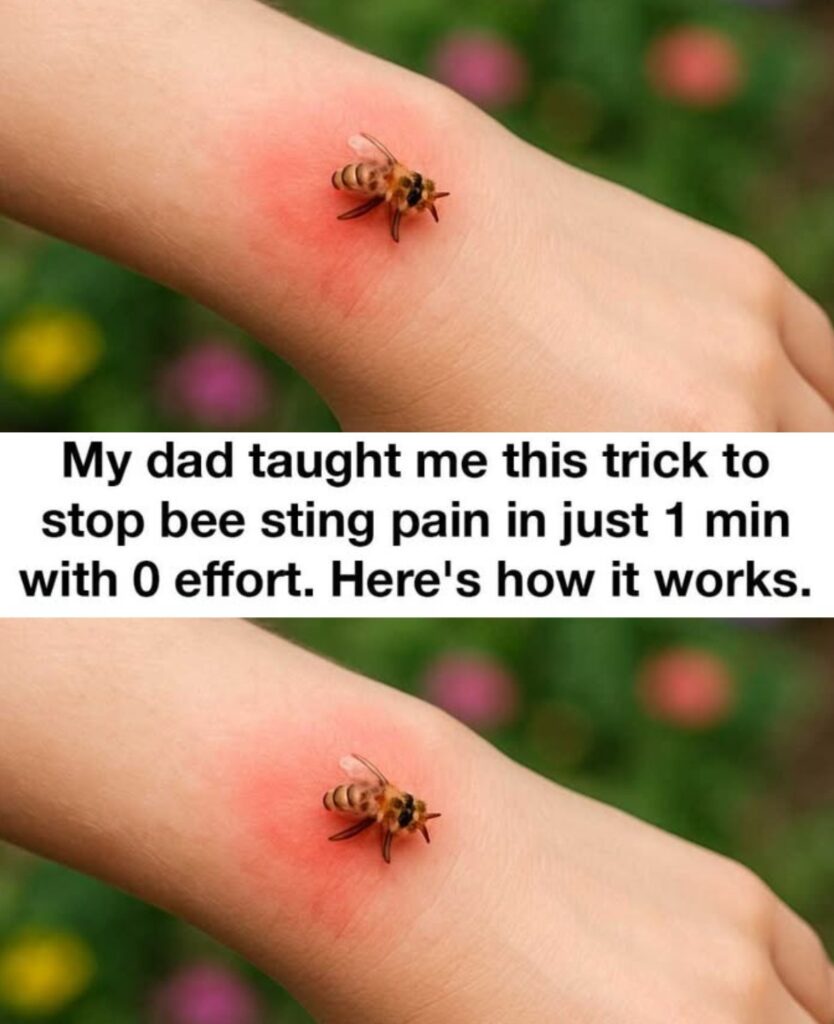
You’re enjoying a sunny afternoon in the garden.
The birds are singing.
The flowers are blooming.
And then — it happens .
A sharp, burning sting on your arm.
You look down — a bee, now flying away.
And within seconds, your skin is throbbing, red, and swelling.
Bee stings are more than just a minor annoyance. For many, they bring intense pain, itching, and inflammation — and in some cases, can trigger serious allergic reactions .
Most people reach for antihistamines, ice packs, or home remedies like baking soda paste or vinegar. But what if there was a faster, simpler, and nearly effortless way to stop the pain — in just 60 seconds ?
My dad taught me a family secret that’s been passed down for generations — a one-minute trick that works so well, it feels like magic.
And today, I’m finally sharing it with the world.
The 1-Minute Bee Sting Relief Trick (My Dad’s Secret)
It’s simple.
It’s natural.
And it uses something you likely have in your kitchen right now.
Step 1: Press a Cold Spoon on the Sting
Yes — a spoon from your silverware drawer .
Here’s how:
Grab a metal spoon (preferably stainless steel)
Place it in the freezer for 1–2 minutes (or run it under cold water)
Press the back of the spoon firmly over the sting
Hold it there for 60 seconds
That’s it.
Within seconds, the burning pain begins to fade .
The throbbing stops .
And the swelling is significantly reduced .
Why This Trick Works So Well
It’s not magic — it’s science and tradition combined .
❄️ 1. Cold Therapy Reduces Pain & Swelling
The cold constricts blood vessels, which:
Slows the spread of venom
Numbs nerve endings
Reduces inflammation
Metal spoons conduct cold better than ice — so they deliver faster, deeper relief.
2. Pressure Minimizes Venom Spread
Applying firm pressure helps limit the diffusion of bee venom into surrounding tissue — a trick used in wilderness first aid.
️ 3. Fast & Accessible
No need to mix pastes or run to the store. A spoon is always within reach — perfect for picnics, hikes, or backyard BBQs.
What NOT to Do After a Bee Sting
Avoid these common mistakes:
❌ Scratching – Can cause infection and spread venom
❌ Using tweezers to remove the stinger – Can squeeze more venom in
✅ Do this instead : Scrape the stinger out with a credit card or fingernail
❌ Applying heat – Increases swelling and pain
❌ Ignoring signs of allergy – Seek help if you have difficulty breathing, dizziness, or hives
When to See a Doctor
While most bee stings are mild and treatable at home , seek medical attention if you experience:
Difficulty breathing or swallowing
Swelling of the face, lips, or throat
Dizziness, rapid heartbeat, or nausea
Multiple stings (especially in children or pets)
These could be signs of anaphylaxis — a life-threatening allergic reaction.
If you’re allergic, always carry an epinephrine auto-injector (EpiPen) .
Other Natural Bee Sting Remedies (That Actually Work)
If you don’t have a spoon handy, try these effective, science-backed options :
1. Honey
Natural antiseptic and anti-inflammatory
Apply a small dab to the sting and cover with a bandage
2. Crushed Garlic (with caution)
Contains allicin, which may neutralize venom
Patch test first — can irritate sensitive skin
3. Lemon Juice
Acidic, helps neutralize alkaline bee venom
Can sting — dilute with water
4. Plantain Weed (Not Banana Plant)
Crush the leaves and apply as a poultice
Used in traditional herbal medicine for insect stings
How to Prevent Bee Stings
Prevention is the best medicine:
✅ Wear light-colored clothing (bees are attracted to dark colors)
✅ Avoid floral perfumes and scented lotions
✅ Keep food and drinks covered outdoors
✅ Stay calm and move slowly if a bee approaches
✅ Check for nests near patios, sheds, or trees
Final Thoughts
That simple spoon trick my dad taught me?
It’s saved me — and my kids — more times than I can count.
You don’t need fancy creams, pills, or gadgets.
Sometimes, the best remedies are the oldest, simplest ones — passed down from those who’ve lived close to nature.
So next time you’re stung, grab a spoon, chill it, and press it down .
You might not believe it — until you feel the pain vanish in under a minute.
And now that you know the secret…
pass it on .
Because the best first aid isn’t always in a first-aid kit.
Sometimes, it’s in a kitchen drawer .